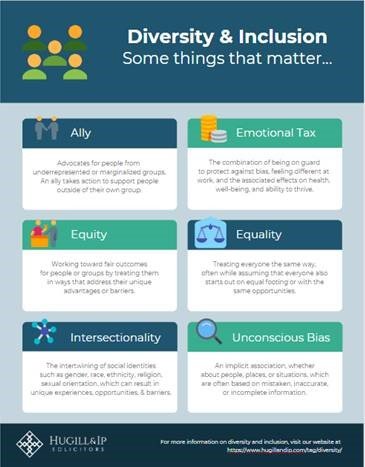Even though Hugill & Ip is a relatively small boutique firm, we try to represent everyone. People of all traits, cultures and diversities that make Hong Kong one of the most international cities in the entire world.
The general scope of our D&I efforts is to give everyone a voice. We strive to tell stories that people will recognise, understand, and relate to. We embrace as many voices and views as possible, as well as give opportunities to people from all backgrounds to tell their own story.
Developing a true sense of belonging and ownership
As many organisations recognise the need and benefits of D&I, there is an undeniable further need for all of us to move beyond branding and simply using it as a marketing tool. We all ought to avoid just promoting the concept of it and rather push the agenda to create a true diverse and inclusive working environment. For us this is the ultimate key to success.
We attempt to be part of external networks and allow diverse participation from members of the firm, which ultimately benefits all of us as individuals, the organisation as a business and society as a whole. We tend to focus on causes we feel passionate about and ones that have a deep meaning to individuals, as well as the firm.
Creating a sense of belonging is crucial: it encourages employees’ tolerance and acceptance of others, whilst also ensuring employees feel accepted, protected, included and cared for. It ultimately creates a team where everyone can be their authentic selves. Whilst at times everyone goes through moments of self-doubt, members of underrepresented groups are much more likely to feel alienated at work. This is especially true when they start a new job, when they work within larger organisations or when they spend a lot of time outside of the workplace for business reasons.
According to several global surveys, the use of diversity competencies for leadership development is widespread. Nearly three-quarters of all organizations include diversity competencies in their leadership development. These organizations recognize the importance of diversity in achieving their business objectives, from attracting top talent (over 70% of respondents believed this objective was directly impacted by a culture of inclusion) to retaining employees (68%) and improving the customer experience (almost 60%).
Differences between mature and underdeveloped organisations or start-ups is glaring. For example, over 77% of respondents from leading organizations reckon that appreciation of differences was an important skill in a leader; just 40% of respondents from underdeveloped organisations or start-ups recognised the value of appreciating differences.
What makes D&I successful?
Diversity is a critical competitive success factor in today’s business world. Organizations with culturally sensitive leaders are generally better positioned to attract the right talents.
We would highlight several elements as key issues:
- Having a clear and genuine strategy.
- Targeting D&I as a normal business practice, not just a box to tick.
- Making sure that the top management not only has a strong buy-in, but also strives to give D&I continuous support.
- Keeping zealous track of progress, whilst rolling out a specific execution plan.
- Recognising examples of success and best practices along the way.
- Creating a constant dialogue and inducing spontaneous conversations within the organisation.
- Identifying allies outside the organisation that feel an integral part of the cause and whom the internal workforce can feel inspired by.
- Empowering employees to influence others, educating their families and friends in return.
The obstacles of a D&I strategy
Despite the popularity of D&I, many organisations struggle to overcome “diversity fatigue”, a term created to identify diversity efforts that are pure lip-service and simply for show. What are the reasons for D&I program failures? What are the pitfalls that many D&I initiatives face?
A number of roadblocks – such as not having time set aside for development, lack of structured training and programs, and lack of support from top management or middle management – prevent organisations from attaining the required D&I maturity.
We all seem to know that D&I is a strategically important thing to do. Numerous studies show that diversity creates more innovation, greater profitability, increases market share and encourages intellectual thought. Such studies show the countless benefits diversity brings, yet some individuals and organisations are averse to diversity. In some instances, their aversity to the subject is strong and they actively resist it.
D&I cannot be force-fed or feel coercive, as the risk is that these efforts will backfire. It is about understanding motivations and what may influence certain individuals to change their behaviours. It is not accomplished by heavy-handed tactics. Stakeholders need to be an integral part of the process and embrace the benefits for them and the whole organisation.
The education and awareness components are paramount. Companies should not be reactive but be proactive and take a step-by-step approach. This can only happen through education: such educational efforts need to be continuous, frequent and communicated in different ways to impact individuals who are in different places on their D&I path.
It is also true that one person alone cannot be responsible for D&I: it takes a team effort and it can be very difficult. When facing hitches in implementing D&I policies we ought to think back about the hiring process, the talent and character component: how many times do we hire based on qualifications and experience, rather than considering the applicant’s contributions on all aspects that the business is focused on? How well do we create a strong team spirit and sense of purpose within organisations? How much time are we committed to investing in fertile grounds for D&I to flourish?
Multiple aspects of D&I
While a strong component of D&I has been focused on sexual orientation and LGBT rights – at least in larger international and/or historically more progressive organisations – there is still a lot of work to be done in Hong Kong. Promoting the benefits of D&I and all its aspects will help it carry more weight in traditional and smaller local businesses. We ought to influence leaders and employees of such businesses to take a stronger stand and encourage a wider level of conversation within their structures. A positive and inspirational influence can propagate throughout the business and have a positive effect in the long-term. A culture of feedback – both formal and informal – can certainly facilitate such purpose.
Along with sexual orientation, surely there’s much more to work on. Organisations should aim to push all aspects of D&I in a stronger way: gender and gender identity, family status, age, race, disability, religious beliefs, body shape or size.
One major step forward in recent times came from the Hong Kong Stock Exchange. In May 2019 they announced that new IPO listing applicants would be required to specifically address gender diversity in their prospectuses. In circumstances where the listing applicant has a single gender board, it would be required to explain the post-listing efforts to achieve gender diversity.
D&I as a path to equity and equality
As many organisations continue to push towards a more diverse and inclusive environments, we should all embrace the concept of “equity” as a core value. The practice of adding equity to D&I is gradually becoming more frequent in non-profit and social justice settings, but it is not often mentioned within corporate D&I efforts – is that perhaps due to the fact that often this concept is very widely misunderstood?
Equity takes D&I one notch up. It encourages fair treatment and access to opportunities, while striving to eradicate the institutional and unconscious hurdles which reduce the potential of diverse members. Equity is generally confused with equality; however, equality does not inevitably accomplish similar results as equity. The difference between equality and equity must be highlighted. While they both promote fairness, equality achieves this through treating everyone the same way irrespective of need, whereas equity achieves this through treating people differently depending on their specific needs. Such different treatment may be key to attaining equality. Equality means giving everyone the same opportunities, but how can everyone have the same opportunities if some are receiving less support than they need in the name of equality? In our opinion equity must play a crucial role in ensuring equality.
Equality and equity may be intrinsically different, but they are also bound together: to create true equality of opportunity, equity is needed to ensure that everyone has the same chance of achieving their aspirations and full potential.
To sum up
D&I is a long-term, progressive path that requires time, practice, and continuous engagement with ourselves and with others. D&I is about being able to value ourselves and feel empowered as our whole selves whilst also enabling others to feel the same. It is everybody’s job to create/facilitate practices and experiences in which individuals feel seen, heard, challenged, connected and transformed.
Every organisation should base their D&I efforts on a few clear concepts and implement them internally and externally.
Do not get left behind! Ultimately, increased diversity and inclusion is an advantage for any organization.





